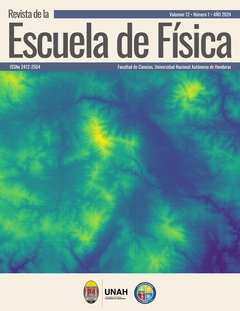Formaciones geológicas en Tegucigalpa a partir de gravedad de Bouguer utilizando polígonos de Talwani
DOI:
https://doi.org/10.5377/ref.v12i1.19423Palabras clave:
Gravimetría, GPS, Anomalías de Bouguer, anomalías residuales, perfil gravimétrico, Geología de HondurasResumen
Exploramos la estructura geológica 2D bajo dos transectos de entre 20 y 25 km de estaciones gravimétricas a través de la ciudad de Tegucigalpa, en dirección O-E y NE-SO, hasta una profundidad máxima de 1,800 m mediante cálculos de gravedad de Talwani para polígonos de forma arbitraria. Para este propósito, producimos tablas de anomalías de Bouguer para el cuadrángulo de Tegucigalpa, calculadas a partir de un estudio previo con valores mejorados para correcciones de topografía y de gravedad normal. Tanto las geometrías de los polígonos como sus densidades aparentes fueron ajustadas dentro de las restricciones proporcionadas por el mapeo geológico, la estratigrafía y secciones transversales disponibles para el área de estudio. La gravedad residual positiva encontrada sobre el centro de ambos perfiles sugiere ya sea un cuerpo ígneo intrusivo o bien una masa de hasta 1500 metros de grosor de lutita y arenisca alterada (formación Jkhg), subyacente a depósitos sedimentarios (Kvn) de 500 a 600 m de grosor. Los valores negativos de gravedad residual se interpretan como resultado del engrosamiento de las tobas volcánicas del Terciario (Tpm) hacia los extremos de ambos perfiles, hasta profundidades de 500 a 1100 m. Sin perder de vista las limitaciones e incertidumbres intrínsecas a modelos de geología subsuperficial
construidos usando únicamente datos de gravedad residual de Bouguer, este estudio plantea una primera exploración gravimétrica de la compleja estratigrafía bajo Tegucigalpa hasta profundidades de 1900 m. sobre longitudes de hasta 25km.
Descargas
309
Descargas
Publicado
Cómo citar
Número
Sección
Licencia
Derechos de autor 2024 Revista de la Escuela de Física

Esta obra está bajo una licencia internacional Creative Commons Atribución-NoComercial 4.0.
© Revista de la Escuela de Física




